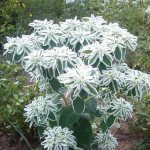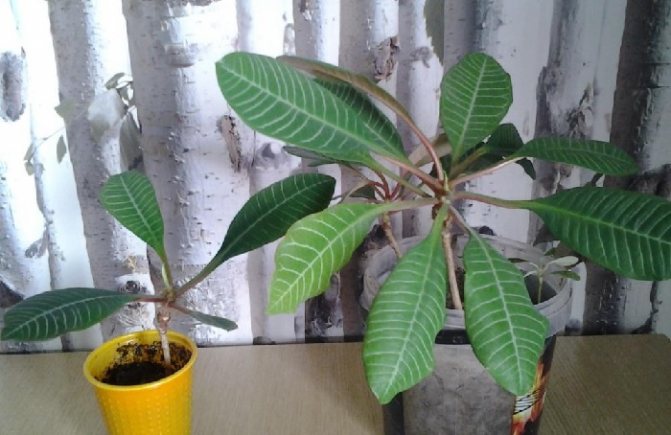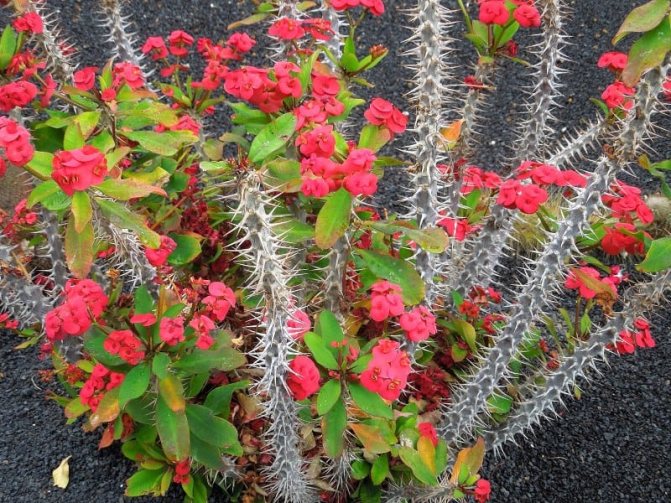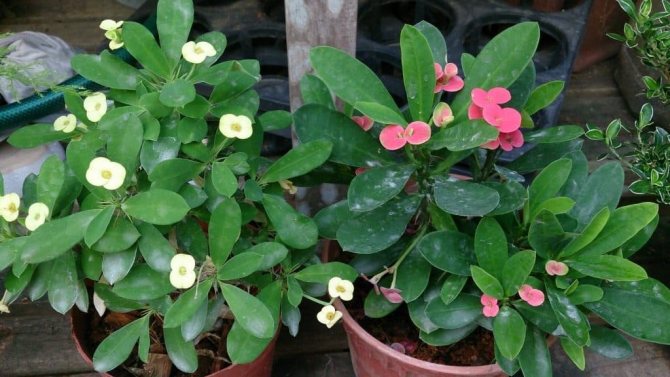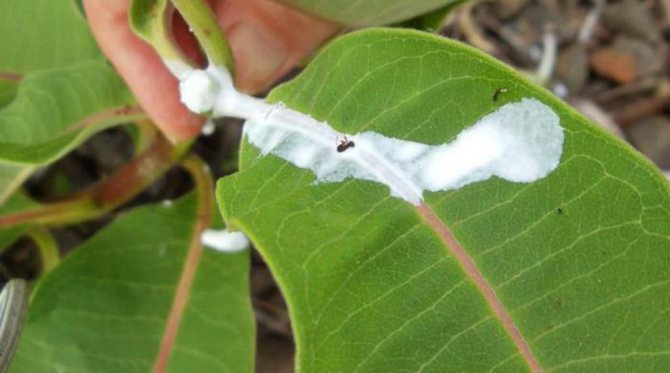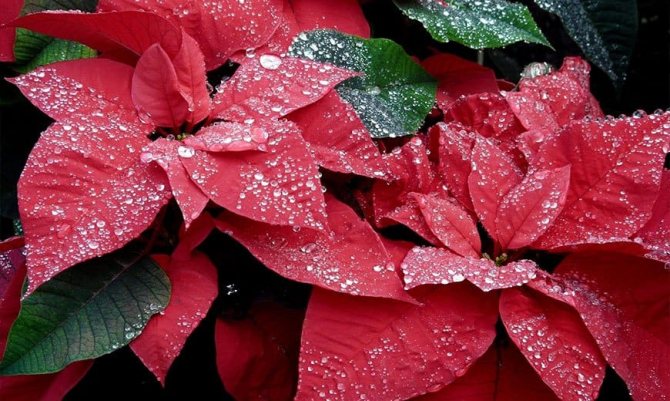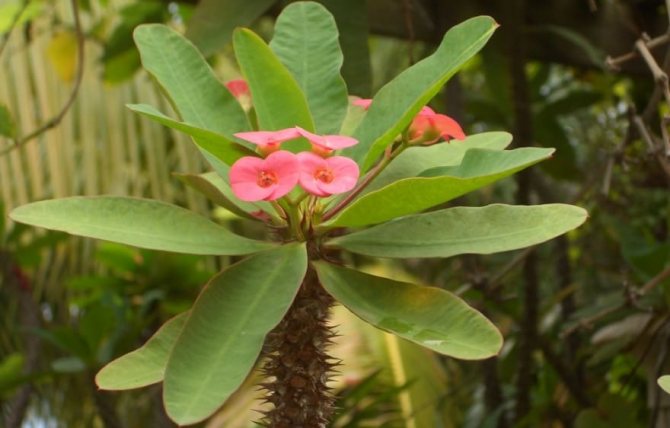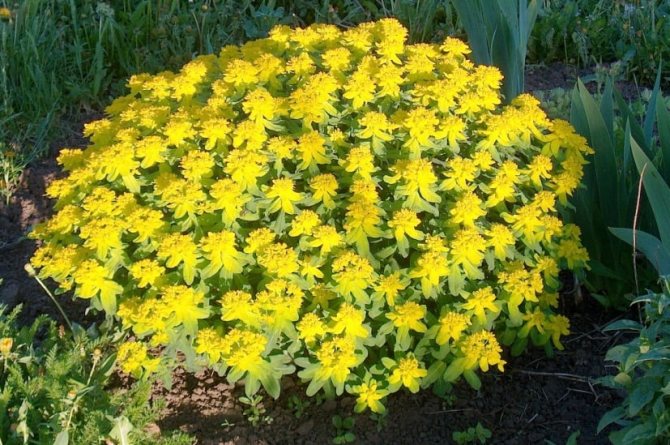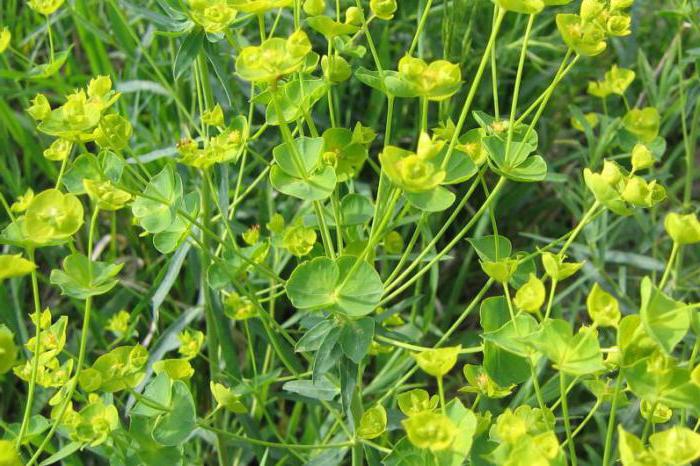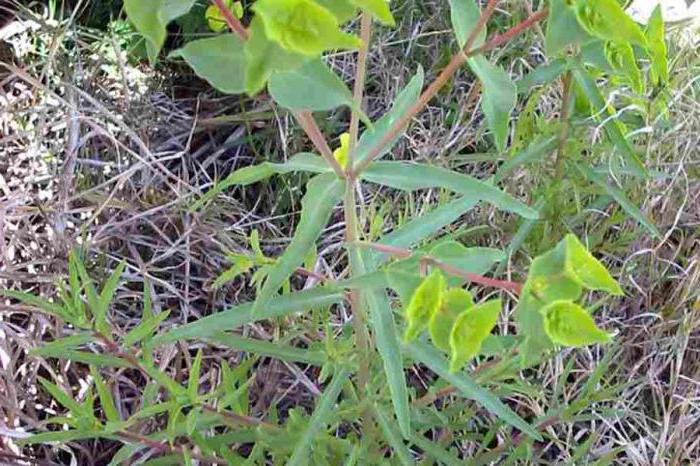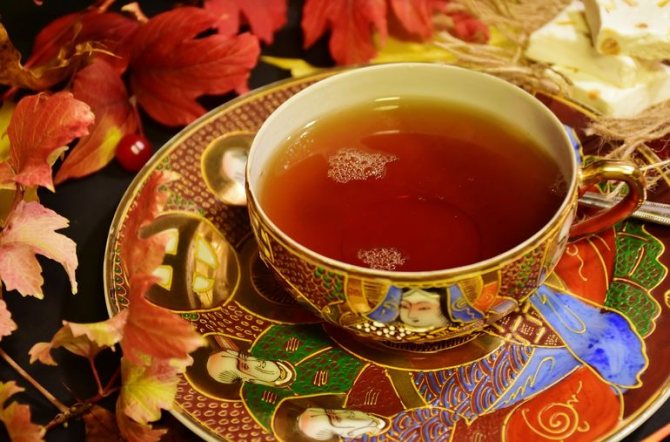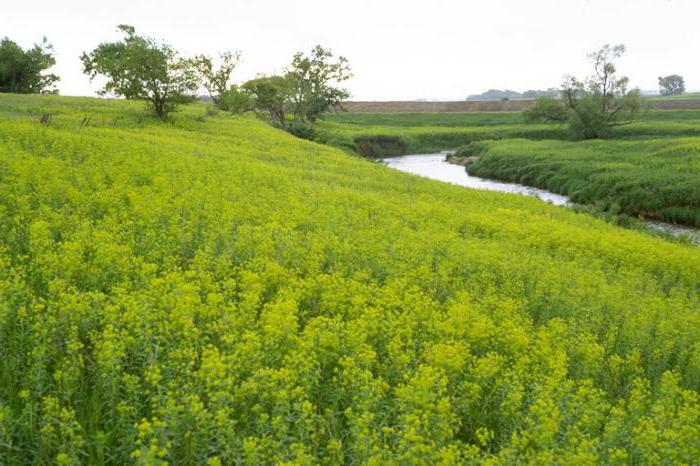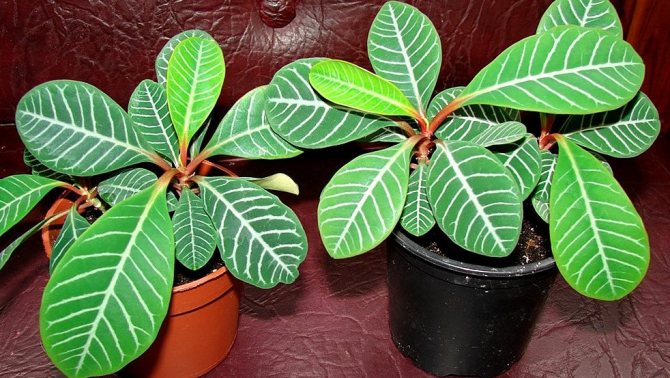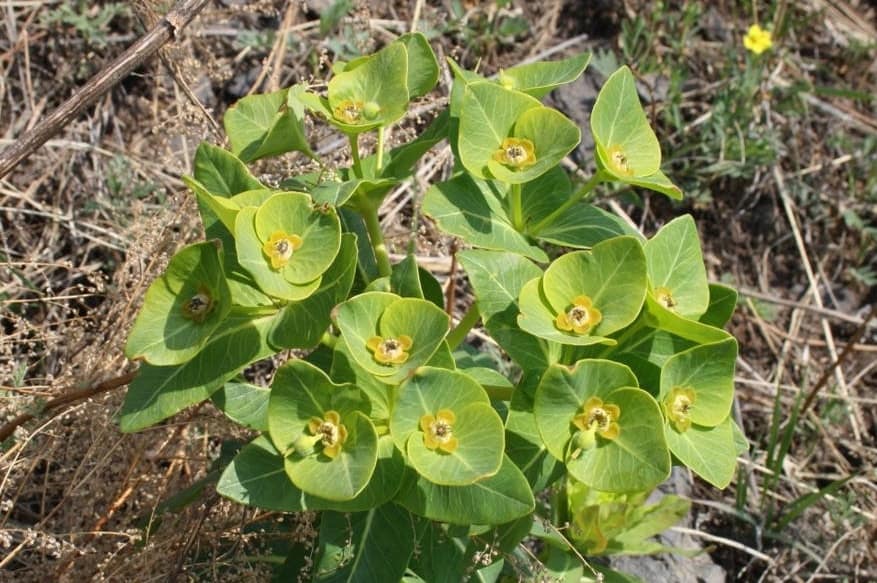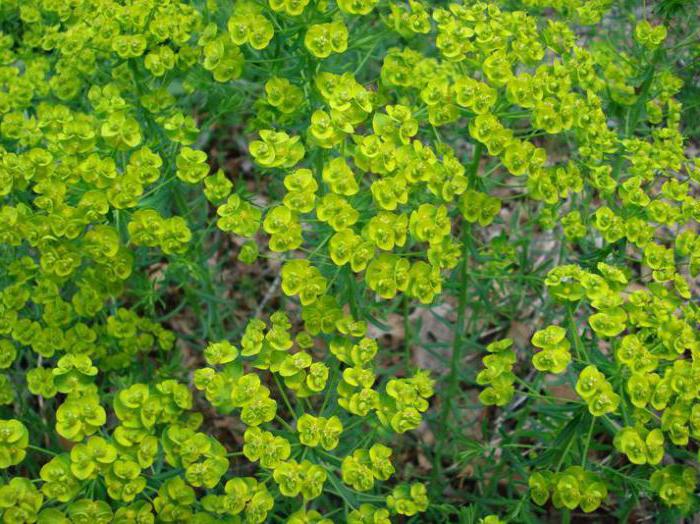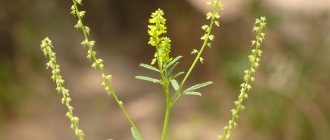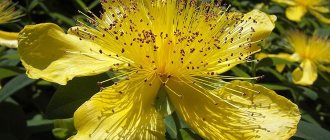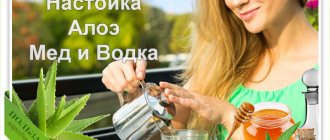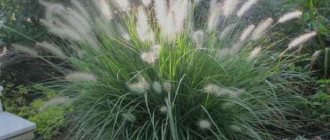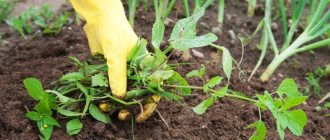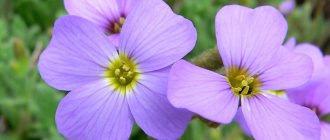Posted in Traditional medicine, Succulents Posted on 23.10.2018 · Comments: · To read: 9 min · Views: 1 827
Euphorbia grass is a common perennial from the numerous milkweed family, which is capable of harming garden crops, drowning their growth, and at the same time helping the human body to cope with a variety of ailments.
This amazing plant comes from Madagascar, but, against the background of climatic changes, it spread throughout the world. More than one and a half hundred species are found on the territory of Russia and the CIS, all of them have one thing in common - poisonous milky juice that fills parts of the grass. This toxic liquid is successfully used in folk medicine, but with caution, nevertheless, the juice contains poisons. What are the benefits of milkweed juice, how dangerous is it and how to use it correctly?
Euphorbia: plant description
Euphorbia belongs to the Euphorbia family, there are many species and subspecies of annual and perennial herbaceous plants, small trees and shrubs of this genus. The area of growth of milkweed is observed in all areas of the continental and subtropical belt of the Earth. The plant got its name in honor of the Moorish healer Euphorb, who was an expert on medicinal herbs and successfully used various plants for a variety of purposes. So, the juice of the Euphorbia plant was used by a doctor both as a medicine and as a poison, to eliminate the objectionable people of the king, with whom he was in the service. The plant got its name in Russian because of the appearance of the juice that is released from the milkweed when the stems or leaves are damaged.
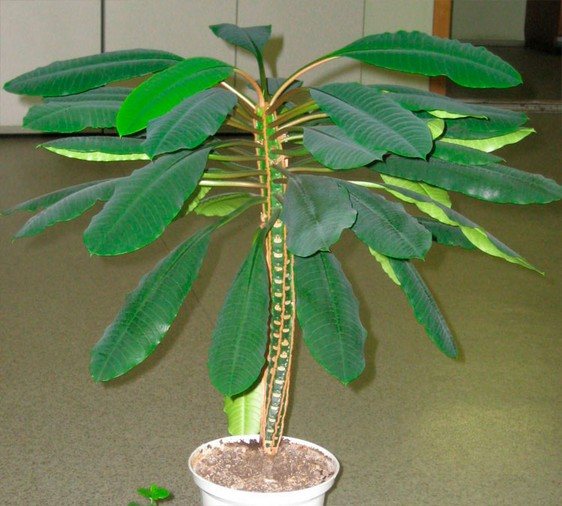
Methods of using milkweed
There are many recipes for how to use fresh juice and prepare milkweed remedies. But it is worth remembering the toxicity of the plant, strictly adhere to the recipe and the recommended dosage.
Infusion for warts
The composition is prepared as follows: 1 tsp of dried raw materials is poured with 500 ml of boiling water and infused under the lid for half an hour. The liquid is filtered and used for baths.
Gastric milkweed decoction
If you suffer from stomach problems, you can prepare the following remedy: 10 g of the root are poured with a liter of water and the composition is boiled for 10-15 minutes over low heat. The broth should be filtered and drunk daily - 1 tbsp three times a day, before meals.
Treatment of lichen and calluses with milk
Fresh juice from the stalk or leaves of the milkweed is applied to the affected areas. And after a quarter of an hour, it is washed off with plenty of water.
When getting rid of corns and calluses, it is recommended to wear socks to enhance the effect and eliminate the possibility of contamination. After each event, it is advisable to treat the skin with a pumice stone, and you can completely get rid of the problem after 5-7 procedures.
Removing unwanted hair
For depilation, a powder is used - dried milk of a plant, which is kept for some time on a glass surface, away from sunlight, but in a warm place.
Before the procedure, you should break 1 tsp of dry product in 100 ml of water and rub the resulting liquid onto the desired areas. After several measures, you can notice the effect - frequent hair removal is not required.
Dyspnea Treatment Powder
To prepare the product, you will need all parts of the grass - the stem, rhizome, foliage. They must be thoroughly rinsed and boiled in a small amount of water. The liquid is drained, and parts of the plant are laid out to dry in a thin layer.
When the plant material is completely dry, it should be ground to a powder and stored in a glass container. The remedy is taken 1 tsp per day, it is recommended to drink it with a small amount of liquid. And also it is recommended to use it for the treatment of epilepsy.
This is just a small part of recipes for making medicinal formulations with milkweed. But, you should not use them yourself, without the preliminary recommendation of a doctor, because we are talking about a plant containing toxic substances. And in some cases, their use is completely contraindicated.


The benefits and harms of milkweed in the house
Euphorbia is a poisonous plant - its juice contains a large amount of substances that, if ingested, can cause severe poisoning. The sap of the plant can cause severe allergic reactions. Given this, it is recommended to keep spurge in homes where there are no pets and children, and it is necessary to transplant with extreme caution.


All types of milkweed contain substances such as rubber, milky juice and resin. Despite the fact that scientists did not conduct a detailed biochemical analysis of the plant, it is known that the components of the milky sap contain euphorbon and amorphous gum. Milk also contains coumarins (hydroxy acid esters), flavonoids (polyphenolic compounds) and alkaloids (nitrogen-containing compounds).
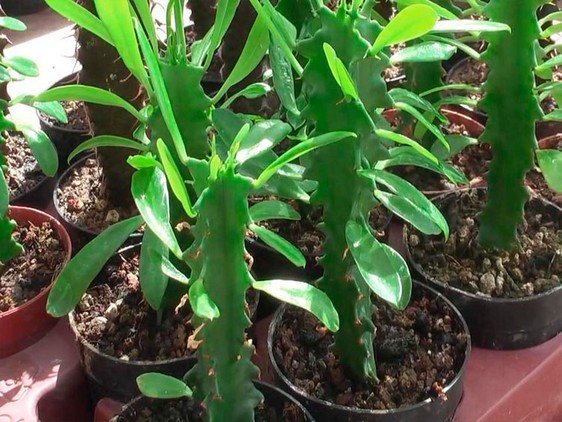

Despite its poisonous properties, euphorbia is a medicinal plant - roots, juice and herbs are often used in the pharmaceutical industry as raw materials for medicines. The sap of the plant has an excellent diaphoretic, anti-inflammatory, diuretic and analgesic effect on the human body. Previously, in the absence of drugs, people treated bites of animals, insects, and long-lasting ulcers with milkweed juice. Also, active enzymes in milkweed juice help to cope with leukemia, providing an immunostimulating effect.
Milkweed root tinctures are used to treat skin and stomach diseases due to the high content of glycosides, tannins and saponins.
Euphorbia cannot be kept at home: myth or reality?
Euphorbia is a potentially dangerous flower, because its juice is one of the strongest toxic substances of plant origin. However, with proper maintenance and compliance with precautions, you can grow it at home.
This houseplant is completely safe when handled carefully. If during transplantation, watering and care you wear gloves and try not to damage the leaves or stems, juice poisoning is impossible. When there are small children or pets in the house, keep the pot out of reach to keep them out of contact with the poisonous liquid.
There is another reason why many growers refuse milkweed in the house - its prickly. The sign says that any plants with thorns bring discord in relations between opposite sexes, can provoke misfortunes, quarrels and diseases.
However, the negative properties of milkweed make themselves felt only if the pot is in the bedroom or recreation area - in all other rooms, the plant will not do any harm.
Endless spurge - benefits for homeopathy and more
The numerous genus of Euphorbia has more than one and a half thousand species, although some botanists are inclined to believe that its number is two thousand varieties.
Euphorbia is a versatile plant.These are herbs, shrubs and trees, sometimes so dissimilar that without specific knowledge you will not guess about their relationship.
Unremarkable representatives of the flora world, vegetable garden weeds, honey plants, ornamental garden dwellers. And finally and first of all - medicinal plants.
In this capacity, a number of milkweed species were known in the ancient world in all lands where they only grew. Its scientific name - euphorbia, it owes to the doctor Euphorb, who served at the court of the Numidian king and described the properties of milkweed in 54 BC. e. Modern medicine confirms the correctness of some of the recipes of ancient herbalists, supplements them with new knowledge about milkweed, but also tirelessly warns fans of homeopathy against dangerous mistakes.
Read also: How to grow romaine lettuce, benefits and harms
The fact is that the spurge got its name from the milky juice in the stems and leaves, white as milk and extremely poisonous.
But, as you know, snake venom can be useful if you know the recipes and follow the measure.
Treatment with milkweed is permissible only with complete confidence in the correctness of a particular choice. It is necessary to consult a specialist and strict adherence to instructions for the manufacture and / or use of medicines based on it.
They come in the form of ointments, alcoholic tinctures, dried herbs, or root for making infusions.
For them, almost all parts of the plant are collected - tops with inflorescences, stems and leaves (but seeds are useless), as well as roots. Euphorbia is harvested from the wild and artificially planted.
The unique benefits of milkweed indirectly and to a large extent come from its powerful branched root system, sometimes going into the ground to a depth of 10 meters, from where the plant extracts pure water and specially designed minerals.
Positive qualities of milkweed according to feng shui
In the right place, a spectacular spurge will not only decorate the interior, but will also benefit the owners of the house:
- The pot located near the front door will save you from enemies and troubles, will become a kind of shield and amulet for the family;
- A flowering plant in the living room will attract happiness and good luck to the house;
- A bush near a computer or TV will absorb harmful radiation.
You can also keep the plant in the office - in this case, the milkweed bush will contribute to a successful career and quick advancement in the career ladder. The possibility of receiving an unexpected bonus also increases significantly. Euphorbia improves relations with bosses and colleagues, creates a positive emotional background, which has a good effect on performance.
When can you benefit from milkweed?
It is noteworthy that the chemical composition of milkweed is still not fully understood, which, however, does not interfere with the diverse use of its beneficial properties.
Much covers the external use of funds in the field of skin diseases. Due to its antiseptic and anti-inflammatory properties, euphorbia is effective in:
· Insect bites and painful animal bites;
· Fungal diseases (not only skin, but also nails).
Also, Euphorbia is able to reduce warts and age spots.
In relation to the gastrointestinal tract, euphorbia acts as a laxative and a means of preventing and treating various diseases, including dysbiosis, hemorrhoids and gastric ulcer.
Also, among the properties of milkweed, one can note its benefits for:
· Treatment of diseases of the bladder and kidneys (as a diuretic);
· Improvement of the upper respiratory tract;
· Strengthening the walls of blood vessels (due to the high content of selenium).
One of the popular names for milkweed - a man-root, comes from its effectiveness in the treatment of diseases in the field of intimate health, accompanied by impaired erectile function.
Regular intake of medications from milkweed is manifested by a rejuvenating and tonic effect, the disappearance of headaches provoked by overwork and stress.
Recently, data have appeared on the effectiveness of milkweed against oncological diseases - its ability through the bloodstream to deliver substances that block their growth to the sites of localization of metastases. However, this information has not been unequivocally confirmed by the world scientific community.
Poisoning with milkweed juice
If the plant sap has nevertheless entered the human body, then it is necessary to act according to the following algorithm:
- take care of providing the patient with peace - physical and emotional;
- the patient is given enterosorbent - activated or white coal, Enterosgel, Polysorb, etc.
- you can quickly remove toxins from the body with the help of saline laxative solutions, for example, Magnesium sulfate;
- a poisoned person should drink a lot - water, mineral water, jelly, non-acidic compotes.
The benefits of milkweed as a honey plant
With its extraordinary aroma and taste, with a slight bitterness and astringency, honey collected by bees from milkweed is the only safe remedy from this plant, the use of which is practically in no way capable of harming a person.
Euphorbia honey is dark brown, has a liquid consistency and does not sugarcoat for a long time. Having tried it once, it will no longer be confused with any other honey.
The specific taste of honey is due to the high content of iodine, the importance of which for human health cannot be overestimated and iodine, in particular:
· Serves as the foundation of thyroid health;
· Strengthens the nervous system;
· Participates in hematopoiesis and increases the level of hemoglobin;
· Has a positive effect on mental abilities and other functions of the brain.
Euphorbia honey with its complex of biologically active substances can replace any simple complex recommended for vitamin deficiency.
Read also: How to make a trellis with your own hands: basic rules, types, tips
It is also useful for:
· Cardiovascular system, including prevention of varicose veins;
· Prevention of liver diseases;
· Relief of symptoms of rheumatism;
· Improving the condition of the skin, nails and hair.
Taking this honey is no more difficult than any other. For example, for insomnia, you can dilute a spoonful of sweets in milk. Or use it with herbal tea (rosehip, fireweed) to strengthen immunity and improve metabolism.
Black radish juice with honey is a folk remedy for a cough that torments you with a cold.
Outwardly, honey is used, in particular, in applications for wound healing.
Where is it better not to put
There are not many places in the apartment suitable for milkweed. When choosing, you need to be guided by the following rules:
- Cannot be placed in bedrooms or lounges, it will lead to troubles in the family.
- If the spurge is located next to the bathroom or toilet, the positive energy is carried away by the water, and the negative energy remains.
- A plant located near water taps or large containers of water attracts chronic diseases.
- If the flower is nevertheless placed in the bedroom, then it must be removed if the couple is preparing to have a child.
- You can not put in rooms where children sleep or play, spurge will have a bad effect on them.
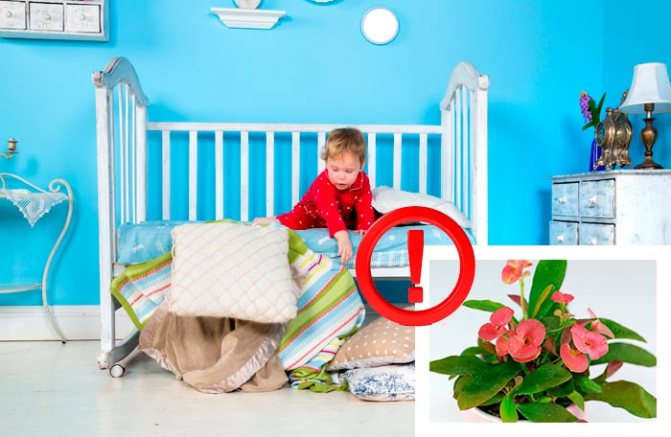

Failure to comply with these conditions, according to the signs, will lead to the fact that the spurge will show negative properties. Due to carelessness, a black streak may begin in the family. First of all, it affects emotions, feelings, personal life. People can part with their second half, and lonely people will not find personal happiness.
What is the harm of milkweed
The concentration of milkweed's harm is its milky juice, which is poisonous not only for humans, but also for most animals.Livestock, however, and almost all wild animals and birds, instinctively keep away from milkweed.
But pets, especially curious cats, are not so careful, so it is not recommended to breed euphorbia on the windowsill if felines live nearby.
It is not necessary to break the stems of the plant to spray the juice - with many plant species, it is enough, say, to touch the leaves, rub the stem and then touch your eyes with your fingers to ensure painful sensations and a lot of risks of visual impairment.
On contact with the skin or mucous membranes, milkweed juice causes burns, redness, inflammation and often an allergic reaction that affects the entire body.
Incorrect intake of milkweed inside as a medicine is fraught with gastrointestinal disorders, including vomiting and diarrhea, as well as a general deterioration in well-being, convulsions, a feeling of suffocation, metabolic disorders and the functioning of certain organs.
The list of threats to health can be continued for a long time, but it is better to emphasize again - treatment with milkweed without harm is permissible only with the knowledge, and sometimes under the supervision of an appropriate specialist, and it is undesirable that they were just a traditional healer, and not a professional doctor.
Euphorbia honey, as already mentioned, is practically harmless, but it is not recommended for persons with individual intolerance or contraindication to honey in principle, as well as for those who have been diagnosed with an excess of iodine in the body.
Signs depending on the type of flower
Milkweed has many varieties. Sometimes they are so different that it is impossible to tell right away that they are one and the same plant. Not all species have thorns on the leaves and trunk. In addition, the varieties have different colors and other properties. This is reflected in the signs.
Some of the types are more suitable for specific premises, for example, an office or study at home. Different varieties affect different areas of life, giving a person the strength to realize desires.
Basically, three types are used - triangular, white-veined and Mil. They are considered the strongest and most suitable for the home. Since this flower has a very complex energy, then before buying you need to find out exactly how each of the varieties will affect a person.
Trihedral
The flower received this name because of the trunk, which has a triangular shape. It is one of the most prickly varieties of milkweed. Because of this property, the flower is acquired with care. Due to the abundance of thorns, trihedral spurge can negatively affect the atmosphere in the house.
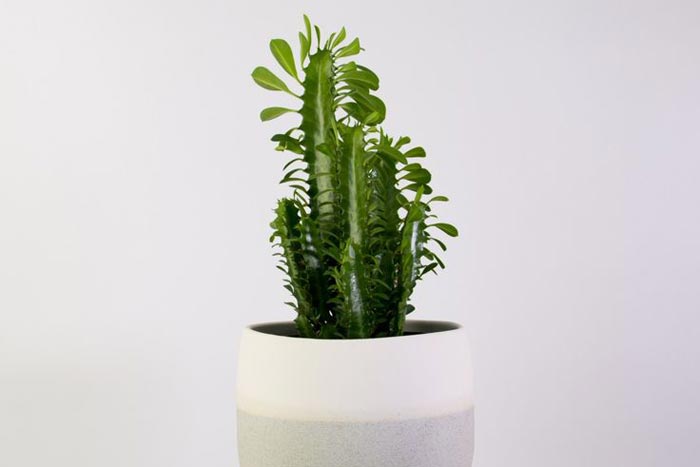

Relatives will start quarreling, stop listening to each other. Therefore, the variety is not placed in recreation areas, in bedrooms, in a nursery. But this variety is an excellent defender. First of all, they put it at the door. This sign is useful if people who want evil live nearby.
White-veined
A much safer variety compared to triangular milkweed. It looks a bit like a palm tree because of the large leaves that grow on a brown stem. Euphorbia is not the most child-friendly flower, but this variety has a number of positive properties.
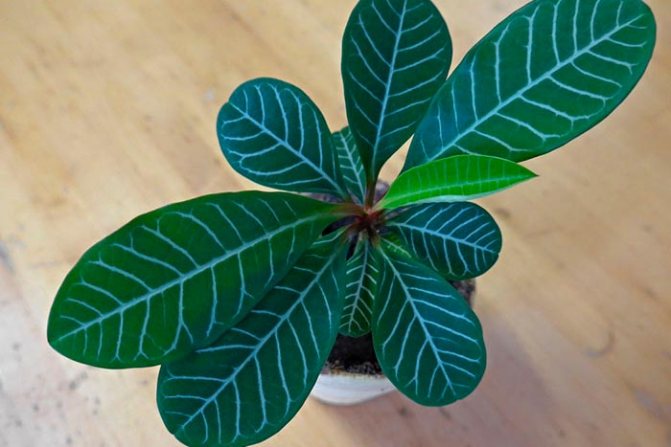

The benefits and harms of white-veined milkweed located in an apartment are as follows:
- Contributes to the improvement of the financial situation.
- Calms down, helps to get rid of conflicts.
- Drives away evil spirits.
- Euphorbia is best at absorbing harmful radiation from a computer.
- Protects the child from negativity, removes the evil eye, protects from everything bad.
- However, signs also warn of possible harmful effects. It is better not to put a plant in children's rooms, otherwise it will attract trouble.
This variety has bright yellow flowers. This is a talisman for the house, especially for a girl. Milkweed will protect you from unworthy men, will not let you connect your life with someone who breaks your heart.The mistress of the flower will be able to save herself for a young man who will really become her half. Therefore, the variety is considered the keeper of the hearth. But still, signs are advised not to put the plant in the bedroom, so as not to provoke quarrels.
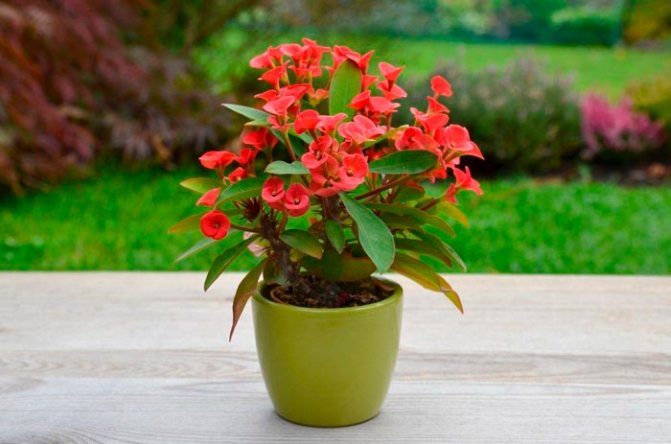

Euphorbia: plant description
Indoor spurge is an ornamental deciduous crop used for landscaping various premises. Due to its attractive appearance, breeders have bred many types of this crop. The plant is quite unpretentious, does not require special conditions of detention. The main condition for keeping this ornamental culture is moderate watering, protection from direct sunlight, since this makes its leaves turn yellow and fall off.


The flower prefers to grow in small pots. Top dressing should be done once every three months. In summer, spurge requires more feeding than in winter. A top dressing used to fertilize succulents works well.
The plant develops and grows rapidly. An adult spurge can reach a height of two meters.
Basic rules for keeping at home
Euphorbia reacts positively to care.
To master the principles, you need to know some rules:
- Lighting... The plant needs a lot of light. Even the direct rays of the sun carry no threat. In the shade, the flower withers and stops growing.
- Temperature... In the natural environment of the tropics, it is warm enough. At home, you need to provide a similar temperature. For full-fledged growth, it should be within + 22 ... + 27 ° С in summer, and + 14 ... + 16 ° С in winter.
- Watering... Euphorbia is a desert shrub that does not tolerate waterlogging. In the warm season, 1 watering per week is enough. During winter, the soil is moistened no more than 1 time per month. The water should be warm and soft at the same time.
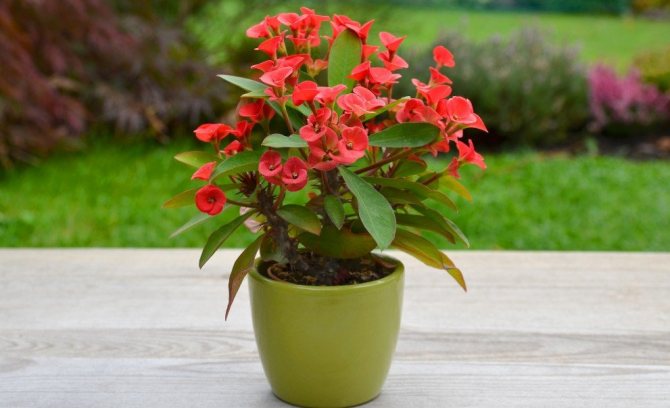

- Top dressing... Fertilizers are applied during the active growth of the flower. This period lasts from early spring to mid-autumn. Top dressing is carried out 2 times a month.
- Pruning... The time for such manipulations is chosen depending on whether the plant is blooming or not. In the first case, this is done at the end of the growing season, and in the second in spring or autumn.
- Transfer... It is carried out only during the rest period. The pot is chosen high and heavy. It is better to transplant by the transshipment method so as not to damage the weak roots. Add new soil and water. At first, the transplant is carried out every 3 years, and then the period is increased to 5 years.
Important! To improve the condition of the flower, it is recommended to spray it or wipe the leaves. It is important not to touch it with your fingers, as the plant does not like it.
Useful properties of indoor milkweed
Although spurge is poisonous, it is also known as an excellent medicinal plant. The pharmaceutical industry uses it as a valuable raw material. Various medicines are made from the roots, sap and leaves of this miracle of nature. Euphorbia is used both internally and externally.
The medicinal properties of this plant were already known before our era. It was used by Numidian physicians for the treatment and prevention of various diseases. The juice in the plant has a wide range of actions, such as:
- Diuretic effect.
- Diaphoretic action.
- Anesthetic effect.
- Antihelminthic action.
- Anti-inflammatory effect.
Read also: Soviet merino: characteristics and descriptions of sheep breed with photos
Also, this indoor miracle was used to treat edema, long-healing ulcers, paralysis. There are known cases of treatment of people affected by the bite of animals, insects, snakes with milkweed.
Ancient Russian physicians successfully used this plant as an emetic and laxative. Also, euphorbia contributed to the cure of age spots, corns and warts.
The unique properties of the flower make it indispensable today. So modern naturopaths with the help of a weak infusion treat diseases such as catarrh of the stomach, fungal lesions of the skin, acute and chronic cystitis, severe headaches, internal and external hemorrhoids, various types of lichen, eczema, diseases of the stomach and respiratory system.
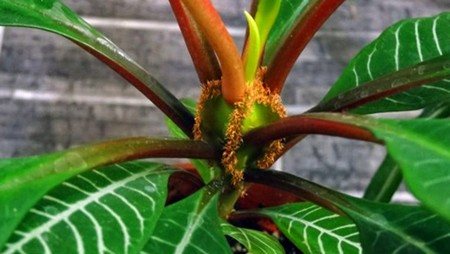

This indoor flower is an excellent anti-inflammatory. A study in rats has confirmed that milkweed extract has great anti-inflammatory activity when used consistently. This property is explained by the presence in its composition of flavonoids, saponins, glycosides and tannins.
With the help of an infusion made from the roots of a medicinal plant, headache is relieved.
In addition, milkweed foliage is an excellent treatment for cystitis and diarrhea.
At the end of flowering, the plant retains three-root fruits with three lobes.
Varieties of garden milkweed Not all milkweed are so intrusive and harmful for gardening, many of them look great on garden beds, without requiring special care:
- Bordered is a pretty plant, the leaves of which have an interesting color. A wide snow-white strip runs along their edges, contrasting with the green of the main background. The plant propagates by itself, by self-seeding.
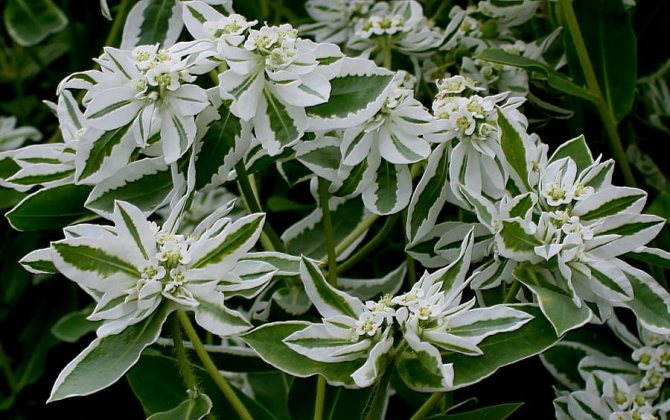

Euphorbia edged
- Cypress - attracts attention during the flowering period, as it is completely covered with bright, greenish-yellow flowers. The bush is easily propagated by cuttings and root cuttings. It gets along well in the new territory, conquering it, therefore, cypress euphorbia is classified as a ground cover plant.


Cypress spurge
- Multicolor - grows as a small, spherical bush that blooms profusely throughout the warm season. There are many flowers, they are bright yellow, giving the plant an elegant look. The variety is resistant to frost, does not need shelter, propagates by cuttings and dividing the bush.
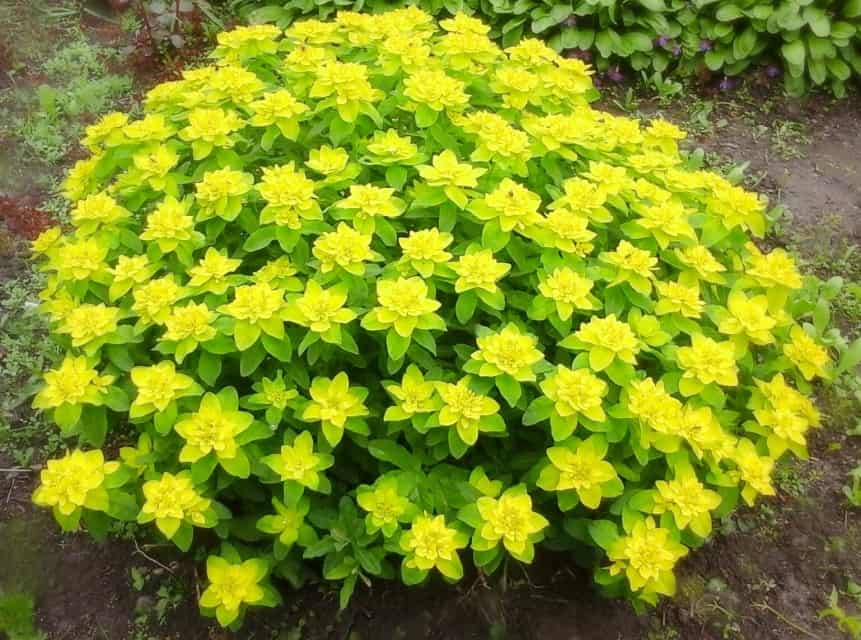

- Almond is a favorite of many gardeners who like it because of the bloom of bright light green flowers that come into motion under the breeze. This half-meter bush is thermophilic, therefore it takes root exclusively in the southern regions of Russia.
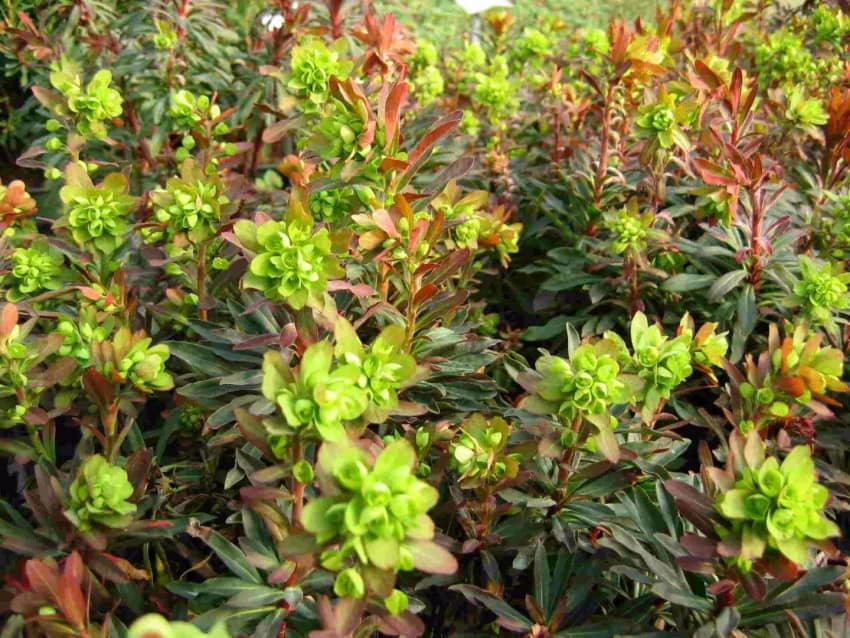

Spurge almond
- Myrtle is another inhabitant of the south, whose height does not exceed 20 cm.When it grows, it forms a beautiful green carpet.


Spurge myrtle
- Capitate - undersized spurge growing in a dense carpet slightly rising above the ground. During flowering, it is covered with yellow flowers.
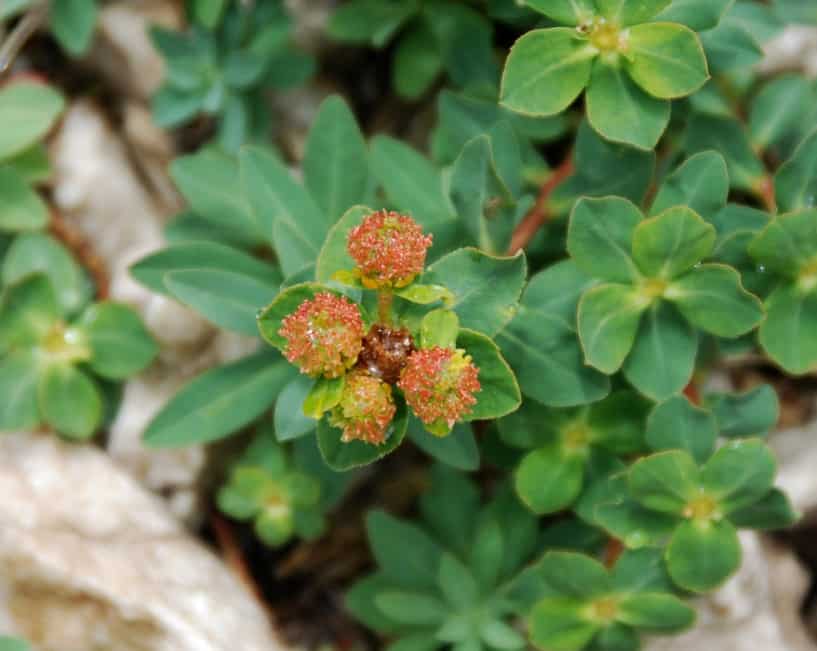

Euphorbia capitate
Euphorbia can be incredibly beautiful or terribly annoying, but in any case, this plant has unique healing properties. People have used its juice in medicine since time immemorial and until now it has not lost its relevance.
What harm can euphorbia do
Euphorbia is a poisonous culture, since the leaves and stems contain a large amount of hazardous substances that can cause severe poisoning of humans and animals. Also, in contact with the skin, the sap of the plant can cause severe allergic reactions. Symptoms usually begin within one hour. At first, there is a burning sensation in the area of contact with the plant. Then this feeling spreads throughout the body, limbs go numb. After some more time, shortness of breath begins. If you do not call the emergency department staff, it is not difficult to guess how this could end.
If milkweed juice gets inside the body, serious problems with the digestive system can occur.
The culprit for all this is the substance euphorbin, contained in the sap of the indoor flower.
Fatal cases of poisoning with this plant, of course, are not known. But, in any case, small children and pets should always be kept away from milkweed.After all, there are many cases when little fidgets tore off or bite off the leaves of indoor plants out of curiosity. It's good that not all indoor flowers are poisonous.
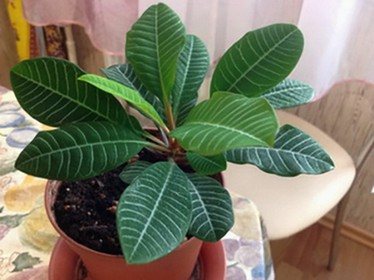

With all the set of useful properties, it is impossible to self-medicate. Treatment must be carried out under the supervision of an experienced herbalist or herbalist. They will help you choose the best and safest therapy.
This does not only apply to internal use. Since long-term external use can lead to inflammatory processes, since it contains irritating elements.
You should beware of getting the juice of the plant in your eyes. This can contribute to loss of vision.
Pregnant and lactating women are strictly prohibited from treatment with this plant.
Precautions
To avoid poisoning or skin problems, it is recommended that you follow some precautions:
- exclude contact with children;
- do not personally prepare medications based on milkweed;
- do not accept handicraft products;
- do not exceed the dosage and do not change the treatment regimen;
- all work with the plant should be carried out only in personal protective equipment.
As you can see from all of the above, Euphorbia is a rather dangerous plant that you need to be careful with. However, adhering to all the rules outlined in our article, you will not get anything but the benefits of "communicating" with a flower.
Varieties
Garden
The most common: Cypress, Sharp, Rod-shaped, Solntseglyad.
Cypress
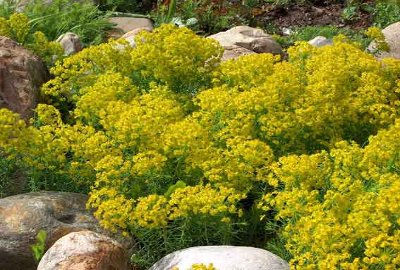

Cypress spurge is a perennial shrub.
Growing in our country almost everywhere, is planted in public places, gardens, serves as a beautiful frame for flower beds and garden paths.
Height 30-40 cm, blooms twice a season, the first time in early summer, the second in September and early October.
The petals are golden.
All parts of the shrub are used as raw materials for the manufacture of medicines. They make infusions, which are used as an antibacterial and antiemetic and general tonic.
Acute
Perennial, common in the European part of the country, in Siberia and the Far East. Height - 20-30 cm, blooms in the middle of summer, lemon-colored petals. The broth is a laxative. With the help of the ointment they get rid of from warts, heals wounds.
Rod-shaped
Annual, up to a meter in height, blooms from June to September, amber inflorescences, used in the form of tinctures, as a tonic and anti-inflammatory agent.
Sungazer
Euphorbia is a perennial herb found everywhere in our country. Planted in orchards and vegetable gardens, as a decorative adornment, is found in the wild.
Height 15-30 cm, flower green - yellow, blooms in July - August. Tinctures used as an antipyretic, an emetic and diuretic, is used to heal wounds.
Room
Belozhilkovy
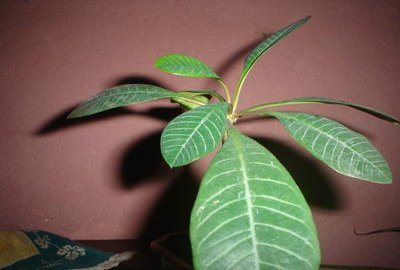

Indoor plant, a little palm-like, grows up to 1.5 m in height, the name is from the type of leaves, white veins are visible on the visible surface.
Triangular
It has an unusual branched triangular stem, flowers are located along the entire stem and its branches, purple in color.
The plant is very unpretentious, does not require special care, the length of an adult specimen can reach 2 meters.
Fat
Highly looks like a cactus, the stem resembles an ordinary ball, along the entire surface, from the bottom up it is divided by growths on which thorns are visible, very unpretentious, rarely blooms, gives one bright red flower.
Recommended: Decembrist (Schlumberger)
"Medusa's head"
The main stem is underground, and numerous branches are visible on the surface, which bloom. "Medusa's head" looks spectacular in hanging pots on the wall. Unpretentious, in winter, development practically stops, only minimum watering.
Photo
Below you can see the homemade milkweed species in the photo:
Wild
The most famous species: Swamp, Glossy, Fiery, Pallas.
Swamp view
It grows in the European part of the country and in the regions of the Far East. Can grow in water, reaches a meter in length, blooms in May-June. The flower petals are purple.
Glossy
It is found in meadows and fields, at the edges of the forest, blooms in May - July, decoctions are made from leaves and roots, used as a laxative, diuretic and emetic.
Fiery
Perennial shrub, height up to 80 cm, red flowers, blooms in June.
Pallas
Better known as: man-root, male root. Distributed in the Far East and Transbaikalia, a perennial with lemon flowers, reaches 40 cm.Infusions of this milkweed used in the treatment of prostatitis, impotence, used for wound healing and as a tonic.
In addition to the previously listed species, the following types of milkweed are very popular:: Multi-flowered, Bordered, Tirucalli, Ribbed, Mila.
Name
The Latin generic name for milkweed in botany is Euphorbia... There is a version that it comes from the name of the ancient Numidian healer Eforba, who was the first to use plants for medicinal purposes. As for the Russian name, the spurge got it for its white, opaque juice, which looks very much like milk.
Alternative names
For its merits in the fight against male ailments, the euphorbia received popular names - the root man and the exile. Also, due to some historical confusion among botanists, it is more often called Pallas or Komarov's milkweed.
First aid for poisoning
Algorithm of actions in case of poisoning:
- Call an ambulance.
- Drink 3 liters of cold water and induce vomiting.
- Take activated charcoal or Enterosgel.
- Try to lie down and wait for a doctor.
If a person feels itchy skin or his tongue is swollen, they take Suprastin or another antihistamine.


Caution does not hurt
When pruning, transplanting and other work, you should be careful: do not forget about rubber gloves, the need to thoroughly wash not only hands, but also face with soap and water. It is better to keep pots with some indoor plants out of the reach of children and pets, or move them to another room. It would be nice to contact the chief sanitary doctor of Russia Gennady Onishchenko with a request that he instruct all trade organizations to accompany the price tags of a number of indoor plants with a warning inscription: "Caution, they are poisonous!"
Some have dangerous green parts, others have fruits or seeds. There are also some handsome men who want to be put in a cage, they are so poisonous. Here is just a small list (it can be continued) of the most popular plants: akalifa, alocasia, anthurium, aucuba japonica, gloriosa, dieffenbachia, datura, codiaeum (croton), groundwort, crinum, milkweed, oleander, syngonium, solianum (nightshade), strophantus, philodendron and hoya.
Symptoms of flower intoxication
With improper treatment with a green doctor or accidentally swallowing parts of it, a person experiences symptoms of acute gastroenteritis:
- severe nausea;
- frequent vomiting;
- diarrhea;
- a feeling of pain and burning in the esophagus;
- flatulence;
- headache;
- severe cramps in the peritoneal region;
- weak cardiac activity;
- an increase in body temperature;
- severe weakness;
- hypotension;
- dry mucous membranes;
- dehydration.


When the milky fluid enters the skin, its redness, swelling, and blistering are noted. The effect of indoor milkweed poisonous on the skin is shown in the photo.
After the juice gets into the eyes, there is lacrimation, redness, inflammation of the conjunctiva, blindness, sometimes irreversible. Milkweed juice is very dangerous for people suffering from allergic reactions, as it can cause Quincke's edema in the victim.
Dangerous and beautiful
Akalif
(the Euphorbia family) is impossible not to notice, she is so good.Most often grown bristly-haired Akalifa ("fox tail") with green foliage and original hanging shoots of pink-raspberry color. You have to tinker a lot with this plant so that it grows beautiful and blooms for a long time. It is necessary to provide akalife with a bright (without direct sunlight) place, warmth, nutritious soil, watering and regular spraying in summer. The plant does not tolerate dry room air, especially in winter. Faded inflorescences must be removed, and the stems must be shortened (be careful!). It is better not to replant old plants, but to limit yourself to replacing the top layer of the earth in the pot in which they are located. Akalifa can be easily propagated by cuttings (in spring and summer), which quickly take root even in water.
Alocasia
you need warmth, light shading in the summer, regular watering (without waterlogging) all year round, spraying and removing dust from beautiful leaves. When transplanting, take care not to damage the roots. The soil mixture should be nutritious and loose. You can add chopped sphagnum moss to it. The most difficult period for alocasia is the end of autumn and winter. Alocasia is classified as a poisonous plant, its juice strongly irritates the mucous membranes of a person. Despite this, some people try to use alocasia as a medicinal herb.
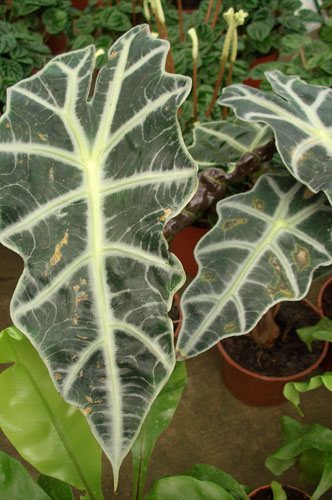

Aukubu Japanese
, or rather its variegated form with an abundance of bright yellow spots, is called the "golden tree". To some, less bright spots resemble fat in a slice of sausage. Hence another name for the Japanese aukuba: "sausage tree". There will be no problems with cultivation if you keep the aucuba in a cool place in the autumn-winter time, and in the summer you put the pot with the plant on the balcony (in a slightly shaded place) or in the garden. It is most difficult for a plant in autumn and winter. At this time, abundant watering can destroy it. A sign of deterioration in the condition of the aucuba is the appearance of black spots and leaf fall. Dense leathery leaves should be wiped with a damp cotton swab to remove dust from them. Aucuba can be grown from a cuttings placed in water. To enhance the branching of the shoot, the top is cut off immediately after rooting. In order not to damage the roots, it is better to replace the transplant with a transshipment. The plant should not be kept in areas where children and pets play, as it is poisonous. If the poison gets inside, such "troubles" as diarrhea, serious inflammation of the stomach and intestines, blood in the urine, etc. are possible. Especially dangerous are the fruits of aucuba - red berries obtained as a result of artificial pollination.
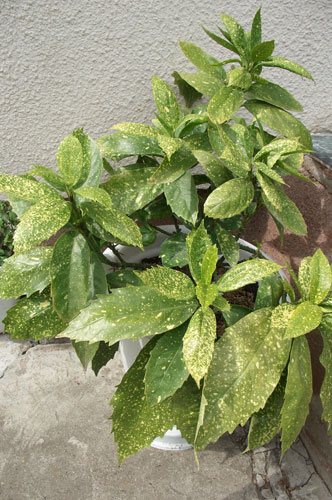

- a very elegant houseplant. Not all lovers have it grows with luxurious leaves. Often, a long, curving, bare stem with several leaves on top of the head stretches to the ceiling. The most capricious hybrid bush dieffenbachia, they hardly tolerate dry air in our rooms. Decorativeness is lost for many reasons. These aroid plants need warmth, high air humidity, partial shade in summer and a bright place in winter all year round. A lot of dust accumulates on the leaves, which must be removed with a damp sponge or cloth. Water the dieffenbachia with soft water without chlorine. A plant with a bare stem, if necessary, is renewed from stem cuttings. When transplanting, use loose soil mixtures rich in humus. They are diluted with sand and turf soil. Dieffenbachia juice (and they decorate classrooms in schools, apartments and houses where there are children) is very poisonous. It has paralyzing properties. This is really dangerous.
(datura) blooms beautifully, so it is often planted in flower beds and grown as a container crop. They also keep datura in flower pots as a houseplant. Datura is unpretentious (like all nightshades), photophilous. In summer, during flowering, it is watered abundantly, in dry weather it is sprayed to increase air humidity. In the warm summer, pots of dope are put on the site.Datura is kept in a cooler place in winter. In the dry air of rooms and with a lack of light, the datura loses some of its leaves. The plant is easily propagated by seeds and cuttings, which take root within two weeks. Do not follow the advice to use Datura as a medicinal plant. “The plant is poisonous. Only an experienced herbalist or homeopath can prescribe his preparations ”(RB Akhmedov“ Plants are your friends and foes ”). All parts of the plant are poisonous, its juice is very dangerous for the eyes. Plus, you don't need to leave blooming, scented dope in your bedroom overnight. From its aroma you can "burn out".
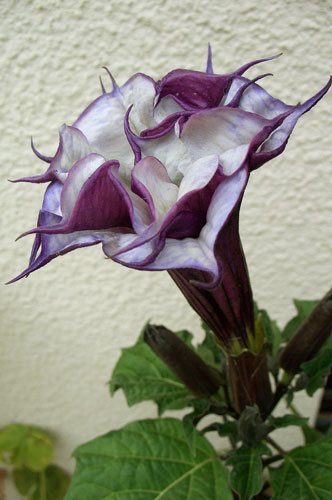

It looks unusual. This succulent plant resembles a bunch of green beads. A light-loving fast-growing plant is best grown in a hanging planter. In winter - in a cool place, for example, on an insulated veranda or loggia. The air temperature at this time should not drop below + 12 ° C. Watering is limited, all fertilizing is removed. Rustic plants are afraid of stagnant moisture in the pot, especially in winter. Rowley's cuttings (short pieces of stem with "beads") are laid on the soil and sprinkled with earth in several places. Rowley's groundwort and other species of groundworm are poisonous plants. They are especially harmful to the eyes and oral mucosa.
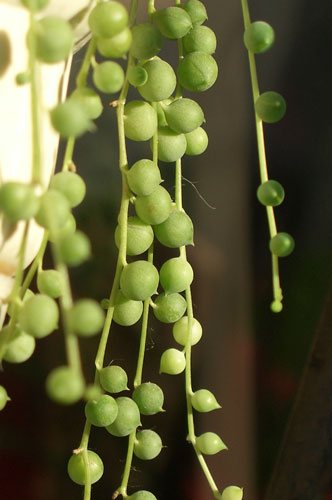

White-veined spurge
(ribbed). In apartments, offices, schools and clinics, you can see a palm-like euphorbia with beautiful leaves and an original ribbed stem. This species of milkweed grows quickly. It actively reproduces by self-seeding, shooting ripe seeds into neighboring pots. It is better not to keep this very unpretentious light-loving plant in the sun in the summer, so as not to spoil the beautiful emerald green color of its leaves. They become brownish. In a shallow wide ceramic pot, you can beautifully plant together a group of ribbed milkweed of different ages, differing in height. The composition will be complemented by stones placed on the soil next to the milkweed. At the slightest wound, a poisonous milky juice appears. Especially easily it gets into human skin during transplantation, if you take a ribbed trunk with hard bristles with your hands.


("Crown of thorns") is often grown in schools, libraries and post offices. For some reason, they often put pots with him in accounting departments. The fast-growing thorny flowering shrub also pleases indoor plant lovers. In winter, Mil's spurge is rarely watered, all feeding is removed. In the summer they are fed with special complex fertilizers for cacti and other succulents. Milky spurge has not only numerous thorns, but also a very poisonous milky juice.
It looks very impressive. This is an unpretentious plant that resembles a complex structure of short sticks. It also contains poisonous milky juice. Euphorbia tirucalli belongs to the most poisonous milkweed.
Other types of indoor milkweed (euphorbia) are also popular. All of them are light-requiring, but in the summer they require some shading from direct sunlight. Growing fast. In winter, they feel good on the windowsills, if there are no drafts and waterlogging. Sometimes in winter, some of the lower leaves fall off, this is normal. Worse when foliage is abruptly discarded during the growing season. All milkweed contains a poisonous milky sap, which appears even from a small wound of the plant. It irritates human skin and mucous membranes.
It blooms beautifully and for a long time. The plant is light-loving. In summer it is thermophilic. In winter, this houseplant is kept in a cooler place. If the oleander does not want to bloom, then it can be "brought up": rearranged in the summer to fresh air (on the site or on the balcony). Watering every evening in summer, much less often in winter. Oleander grows rapidly. Adult specimens have to be kept in tubs. When transplanting, a soil mixture of sod land, humus, peat and sand is used. Flowers appear on young shoots. After the end of flowering, the faded shoots are cut off.Spraying with water and wiping the leaves with a damp cotton swab prevents the appearance of scale insects and spider mites. Oleander cuttings grow roots even in water. This plant is one of the most poisonous. Especially its juice and seeds. You should not enjoy the scent of oleander flowers, a flowering plant should not be kept in a room where people sleep. “Blooming oleander is really so fragrant that being in a room causes severe headaches and even dizziness…. Never chew its leaves. Animals and birds that have eaten oleander leaves die. Even on its leaves and flowers, you can see dying and dead flies. When pruning oleander, try not to splash the juice in your eyes or rub your eyes with your hands. Be sure to wash your hands after handling oleander. Remember: oleander is poisonous - it is the “brother” of strophantus ”(NM Verzilin“ Traveling with houseplants ”).
Poinsettia
(or poinsettia, "Christmas star", the most beautiful euphorbia). This beautiful plant, which can be grown for a long time as an indoor plant and stimulate its flowering by a certain date, is described in detail in the article "Christmas star (poinsettia, the most beautiful euphorbia) before and after the winter holidays." This type of milkweed is associated with the winter holidays. You can read about the ability of the most beautiful milkweed to improve mood in the article "Houseplants blooming in autumn and winter as a remedy for depression." Poinsettia reminds of its belonging to milkweed by the presence of poisonous milky juice. You can read more about the cultivation of this plant in the article ““.


Poinsettia ("Christmas Star")
Solyanum
(nightshade) unpretentious. It grows well in indoor conditions, turning into lush bushes. This moisture-loving plant can shed some of the leaves when the soil is waterlogged. Winter is a difficult period for Solyanum. It is better to keep it in a bright and cool room at this time. There he will retain his elegant appearance for a long time. In a warm place, nightshade quickly sheds fruits and part of the leaves. At the end of winter (before the start of growth), solyanum is formed: part of the branches is removed and shortened. The plant propagates by seeds or cuttings. Seedlings of saltanum grow well in the open field in summer. They must be pinched in order for the plant to bush. Solyanum has red fruits that look like tiny tomatoes. Children find these poisonous berries so appetizing that they want to try them.
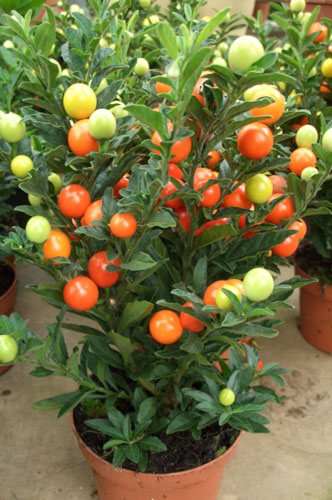

Strophantus
("Twisted rope") has beautiful flowers. In some of its species, they are fragrant like a rose and unusual in shape. This delicate tropical plant requires warmth, diffused light, moisture, good nutrition and support. Propagated by seeds and cuttings.
In tropical Africa, healers use its juice to prepare medicines that help with fever and skin diseases. Hunters grease it with juice on the ends of the arrows “The arrowhead, smeared with the juice of strophantus, struck to death both people and wild animals. Death came almost instantly, as this poison stops the activity of the heart ”(NM Verzilin“ Traveling with houseplants ”). Different types of strophantus have different effects on humans. To isolate the active substance (strophanthin), specialists transport plant seeds in containers that are carefully closed. The sap and seeds of strophantus are extremely poisonous.
> > > >
Or Euphorbia, a genus of plants in the Euphorbia family. The homeland of milkweed is the subtropics of Africa and America. It was there that it adapted to survive in the conditions of the scorching unbearable sun.
All types of milkweed have a white juice inside the fleshy stem, similar to milk. The plant got its name from this resemblance to milk. According to an ancient legend, the doctor Euphorbos cured the ruler of Numidia with milkweed juice, who later immortalized the name of his savior.
The chemical composition of milkweed
:
- rubber;
- milky juice;
- resin;
- euphorbon;
- amorphous gum;
- coumarins (hydroxy acid esters);
- flavonoids (polyphenolic compounds);
- alkaloids (nitrogen-containing compounds).
Due to such a rich pharmacological content, euphorbia is used in medicine. Preparations from leaves, stems, flowers, roots and milky juice are used to heal wounds, as well as a diuretic, diaphoretic, analgesic, antihelminthic and anti-inflammatory effect. You can read more about the beneficial and medicinal properties of milkweed herb.
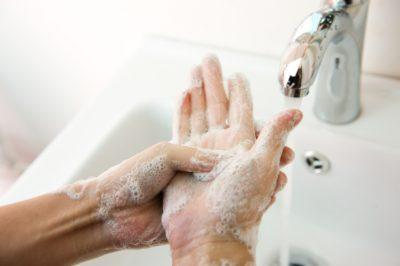

How to prepare a plant?
All parts of the milkweed are suitable for the treatment of many diseases, but in order to avoid unpleasant complications, you need to know how to properly prepare a useful flower. The roots of the plant are dug up in autumn or spring, when there is no milkweed flowering period. The roots are thoroughly washed from dirt, dried in the oven and stored on the top shelf of the refrigerator.
The inflorescences are harvested in the spring or summer, dried in the sun and stored in thick paper or cotton bags. The leaves of the flower are collected, thoroughly washed and dried on a windowsill or table, then put into a paper bag.
Milkweed care.
Very unpretentious plant, durable. Euphorbia requires almost no care. Very decorative. Watering is moderate, in winter it is enough once a month. They love spraying. The optimum air temperature for milkweed is 20-25 degrees in summer and 12-16 in winter. Our houses are equally warm in summer and winter. Plants grow without complications. It's just that I water it quite often all winter so that the earth does not have time to dry out. The plant is very fond of sunlight, you can safely push it to the first line, closer to the glass. Of course, it is better to place it on a more lighted windowsill. Blooming milkweed is often watered, necessarily fed with potash or complex fertilizer. Non-flowering milkweed can be fed with fertilizers for cacti.
Euphorbia grows well in a mixture of peat, sand, leafy soil, sod land. You can add brick chips to the sand. The seedling mixture is made up in equal proportions.
Propagated by seeds (most often by self-sowing), shoots. After separation from the plant, it is advisable to dry the shoot before planting.
Euphorbia care appreciates and gratefully responds to the love and warmth of the owners. Its slender bushes are pleasing to the eye.
Now the children have grown up and I have a new little euphorbia - it still has to grow and grow.
spurge is poisonous
Here he is, my baby white-veined euphorbia.
Poisonous houseplant spurge.
Euphorbia - benefit or harm from this plant?
Be careful! Any spurge is dangerous! Euphorbia is poisonous!!! It is imperative to instruct children on how to handle this plant. If children are small or naughty or unpredictable, the spurge should be removed higher, out of reach. Euphorbia can bring considerable harm !!!
The fact is that these plants, when cut, broken or simply separated from a leaf, emit a white sap - very unusual and quite attractive for research - such a white drop ... This sap, getting on the skin or mucous membranes, causes a severe chemical burn. When my small children were born, I just threw out my gorgeous tall perennial spurge - I was so scared of the information that I read it on the Internet. I then looked for the name of this plant and found an article where it was told how a teenage girl smeared her face with the juice of this poisonous houseplant. The consequences were some terrible - not just the skin peeled off and a new one appeared - some more persistent changes, up to scars. In general, this is just another example that poisonous houseplants exist.
Procurement and storage
To pick flowers correctly, you need to make sure that the harvested plant is a spurge. Indeed, if the wrong herb is collected, this will not have the desired effect, and otherwise poisoning or other negative consequences may occur.
When harvesting the herb, euphorbia should not be allowed to collect other medicinal plants. It is better to collect in an area where a large amount of it grows.
Folk recipes use root, stems and juice. All of these parts must be procured separately. The juice is obtained from a fresh plant. Then it is evaporated in a water bath and placed in glass containers. Store workpieces only in a cold place.


Milkweed roots are harvested in early spring. This is done before the first leaves appear. You can harvest them in late autumn, when the plant begins to wilt. The dug roots are cleaned of dirt, washed, treated with boiling water and dried at a temperature of 40 degrees.
The stalks and grass of the milkweed are harvested before flowering. After harvesting, the juice is squeezed out, and the plant is laid out for drying.
The color of euphorbia is harvested in rare cases, and then laid out in places where the sun's rays do not fall. The finished raw materials are placed in glass jars for storage.
The dried plant can be stored for no more than 1 year. After this period, its medicinal properties are lost.
Indoor euphorbia flower - poisonous or not, why juice is dangerous
The doctor Euphorba was the first to speak about the houseplant euphorbia (the second name is Euphorba). He discovered medicinal properties in the plant, which later began to be used by folk healers. Nowadays, Euphorbia is one of the most beloved plants among flower growers.
This plant is unpretentious in care and does not require any special conditions of maintenance. But not every person knows that spurge is a poisonous flower. Its milky juice can cause colossal harm to human health. Today we will talk about the flower - indoor euphorbia, determine how dangerous it is and is its juice really so poisonous?

